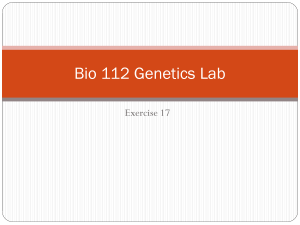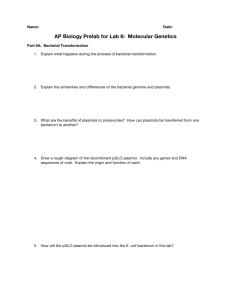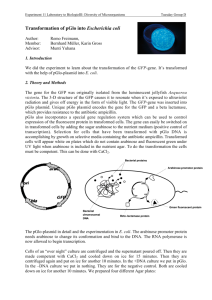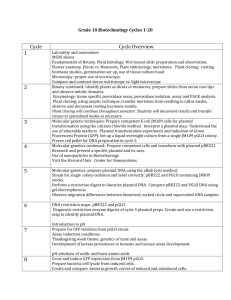Experiment Bacterial genetic exchange:Transformation Advisor
advertisement
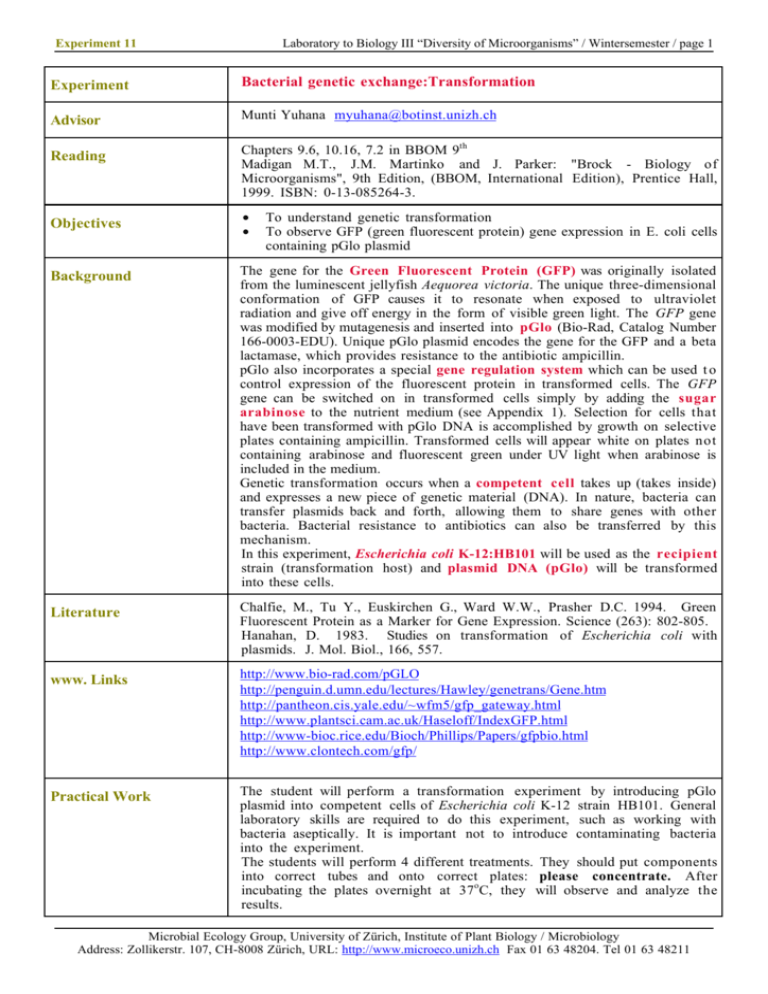
Experiment 11 Laboratory to Biology III “Diversity of Microorganisms” / Wintersemester / page 1 Experiment Bacterial genetic exchange:Transformation Advisor Munti Yuhana myuhana@botinst.unizh.ch Reading Chapters 9.6, 10.16, 7.2 in BBOM 9th Madigan M.T., J.M. Martinko and J. Parker: "Brock - Biology of Microorganisms", 9th Edition, (BBOM, International Edition), Prentice Hall, 1999. ISBN: 0-13-085264-3. Objectives • • Background The gene for the Green Fluorescent Protein (GFP) was originally isolated from the luminescent jellyfish Aequorea victoria. The unique three-dimensional conformation of GFP causes it to resonate when exposed to ultraviolet radiation and give off energy in the form of visible green light. The GFP gene was modified by mutagenesis and inserted into pGlo (Bio-Rad, Catalog Number 166-0003-EDU). Unique pGlo plasmid encodes the gene for the GFP and a beta lactamase, which provides resistance to the antibiotic ampicillin. pGlo also incorporates a special gene regulation system which can be used t o control expression of the fluorescent protein in transformed cells. The GFP gene can be switched on in transformed cells simply by adding the sugar arabinose to the nutrient medium (see Appendix 1). Selection for cells that have been transformed with pGlo DNA is accomplished by growth on selective plates containing ampicillin. Transformed cells will appear white on plates not containing arabinose and fluorescent green under UV light when arabinose is included in the medium. Genetic transformation occurs when a competent cell takes up (takes inside) and expresses a new piece of genetic material (DNA). In nature, bacteria can transfer plasmids back and forth, allowing them to share genes with other bacteria. Bacterial resistance to antibiotics can also be transferred by this mechanism. In this experiment, Escherichia coli K-12:HB101 will be used as the recipient strain (transformation host) and plasmid DNA (pGlo) will be transformed into these cells. Literature Chalfie, M., Tu Y., Euskirchen G., Ward W.W., Prasher D.C. 1994. Green Fluorescent Protein as a Marker for Gene Expression. Science (263): 802-805. Hanahan, D. 1983. Studies on transformation of Escherichia coli with plasmids. J. Mol. Biol., 166, 557. www. Links http://www.bio-rad.com/pGLO http://penguin.d.umn.edu/lectures/Hawley/genetrans/Gene.htm http://pantheon.cis.yale.edu/~wfm5/gfp_gateway.html http://www.plantsci.cam.ac.uk/Haseloff/IndexGFP.html http://www-bioc.rice.edu/Bioch/Phillips/Papers/gfpbio.html http://www.clontech.com/gfp/ Practical Work The student will perform a transformation experiment by introducing pGlo plasmid into competent cells of Escherichia coli K-12 strain HB101. General laboratory skills are required to do this experiment, such as working with bacteria aseptically. It is important not to introduce contaminating bacteria into the experiment. The students will perform 4 different treatments. They should put components into correct tubes and onto correct plates: please concentrate. After incubating the plates overnight at 37 oC, they will observe and analyze the results. To understand genetic transformation To observe GFP (green fluorescent protein) gene expression in E. coli cells containing pGlo plasmid Microbial Ecology Group, University of Zürich, Institute of Plant Biology / Microbiology Address: Zollikerstr. 107, CH-8008 Zürich, URL: http://www.microeco.unizh.ch Fax 01 63 48204. Tel 01 63 48211 Experiment 11 Materials and Experimental Protocols Laboratory to Biology III “Diversity of Microorganisms” / Wintersemester / page 2 Material and equipment needed (per student group): • Bacterial strain: overnight culture of E.coli K12:HB101 in LB medium. LB (Luria Bertani Medium) contains bacto tryptone 10 g/l, yeast extract 5 g/l, NaCl 5 g/l, pH 7.2; agar concentration is 1.5% for plates. • Media and solution: poured agar plates: 1 plate LB, 2 plates LB+Amp, 1 plate LB+Amp+Ara, 1 Eppendorf tube containing 2 ml LB medium, 1 ml sterile transformation solution (50 mM CaCl2 solution). • Equipment: 1 set micro pipettes, 1 box sterile yellow tips, 1 box sterile blue tips, 1 box sterile Eppendorf tubes, 1 Eppendorf rack, 1 foam microtube holder (floating microtube rack), 1 forceps, 1 pack sterile inoculation loops, container filled with crushed ice, marking pen (permanent), clock or timer, tissue paper, waste container. Common work station: 1 vial pGlo plasmid (Bio-Rad, Catalog Number 1660003-EDU), 42oC water bath, thermometer, 37oC incubator oven, UV lamp (long wavelength), safety glasses to protect eyes from UV light, refrigerator, centrifuge for Eppendorf tubes, pH meter, autoclave, Petri dishes, crushed ice, vortex mixer, 500 ml graduate cylinder, 250 ml flask, distilled water. Procedures: see also Appendix 2. Period 1 (transformation experiment): Use sterile technique. 1. Take 2 Eppendorf tubes, label them as +DNA and -DNA, respectively. Fill each with 1.5 ml of the overnight E. coli culture. Centrifuge at 7000 rpm for 2 minutes to collect the cells, then pour off the supernatant. 2. Using a 1000µl pipette, transfer 1000µl of transformation solution (50 mM CaCl2) into each tube. Resuspend the pelleted cells. Place tubes on ice for 15 minutes. 3. Centrifuge at 7000 rpm for 2 minutes to collect the cells, then pour off the supernatant. Add 200 µl of transformation solution into each tube. Resuspend the pelleted cells. Close and place tubes on ice for 10 minutes. 4. Take 10 µl of plasmid solution containing pGlo plasmid DNA and mix (resuspend) well into the competent cell suspension of the +DNA tube. Close the tube and return it to the rack on ice. Do not add plasmid DNA to the -DNA tube. Incubate the tubes on ice for 10 minutes. Make sure the bottom of the tubes make contact with the ice. 5. Meanwhile, label 4 agar plates on the bottom as follows: • LB+Amp (+ DNA) • LB+Amp +Ara (+ DNA) • LB+Amp (-DNA) • LB (- DNA) 6. Using the floating racks as tube holders, transfer both tubes into the water bath set at 42oC and incubate for 50 seconds. Make sure that the bottom of the tubes make contact with the warm water. After the incubation, place both tubes back onto ice. For best results, the change from the ice to 42 o C and then back to the ice must be rapid. Incubate tubes on ice for 2 minutes. 7. Add 250 µl LB medium to the tube and close it. Repeat with a new sterile tip for the other tube. Incubate the tubes for 10 minutes at room temperature. 8. Tap the closed tubes with the finger to mix. Using a new sterile pipette tip for each tube, pipette 100 µl of the transformation (+DNA) and control suspension (-DNA) onto the appropriate agar plates. 9. Use a new sterile loop for each agar plate. Spread the suspensions on the surface of the agar by quickly skating the flat surface of a new sterile loop back and forth across the plate surface. 10. Stack your plates and tape them together. Put your group name and the date on the bottom of the stack and place it upside down, overnight in the 37oC incubator. Microbial Ecology Group, University of Zürich, Institute of Plant Biology / Microbiology Address: Zollikerstr. 107, CH-8008 Zürich, URL: http://www.microeco.unizh.ch Fax 01 63 48204. Tel 01 63 48211 Experiment 11 Laboratory to Biology III “Diversity of Microorganisms” / Wintersemester / page 3 Period 2 (Observations): Observe the phenotype of the colonies under the long-wave UV light. Observe what you see on each of the four plates. Record your data and compare the +DNA cells with the non-transformed E. coli. Laboratory Rules & Precautions Handling E.coli K12:HB101 requires the use of standard microbiological laboratory techniques. Collect all of the waste materials in a biohazard bag, and autoclave them. All contaminated liquid and solid wastes will have to be autoclaved before disposal as well. Please wash your hands after you have handled material containing recombinant DNA molecules and before leaving the laboratory. All procedures are performed carefully to minimize the creation of aerosols. Eating, drinking, smoking and applying cosmetics are not permitted in the work area. UV radiation can cause damage to eyes and skin. Short-wave UV is more damaging than long-wave UV light. Use UV protection glasses. Experiences gained Familiarity with genetic transfer processes from one organism to another with the aid of plasmid DNA. Understand the Green Fluorescent Protein (GFP) gene expression in E.coli. GFP was originally isolated from the bioluminescent jellyfish Aequorea victoria and cloned in Escherichia coli cells. Timing 90 minutes. Reporting Keep proper notes on experimental steps and observations in your laboratory book. Questions Microbial Ecology Group, University of Zürich, Institute of Plant Biology / Microbiology Address: Zollikerstr. 107, CH-8008 Zürich, URL: http://www.microeco.unizh.ch Fax 01 63 48204. Tel 01 63 48211 Experiment 11 Laboratory to Biology III “Diversity of Microorganisms” / Wintersemester / page 4 Appendix 1. The three genes (araB, araA and araD) code three digestive enzymes that are involved in the breakdown of arabinose. They are clustered together as arabinose operon. These three proteins are dependent on initiation of transciption from a single promotor (PBAD). Transciption of these three genes requires the presence of the DNA template (promotor and operon), RNA Polymerase, a DNA binding protein called AraC and arabinose. AraC (a regulator protein) binds to the DNA at the binding site for the RNA Polymerase (the beginning of the arabinose operon). When arabinose is present in the environment, bacteria take it up. Once inside, the arabinose interacts directly with AraC which is bound to the DNA. The interaction causes AraC to change ist shape which in turn promotes the binding of RNA Polymerase and the three genes (araB, araA and araD) are transcribed. In the absence of arabinose, the AraC returns to its original shape and transciption is shut off. Microbial Ecology Group, University of Zürich, Institute of Plant Biology / Microbiology Address: Zollikerstr. 107, CH-8008 Zürich, URL: http://www.microeco.unizh.ch Fax 01 63 48204. Tel 01 63 48211 Experiment 11 Laboratory to Biology III “Diversity of Microorganisms” / Wintersemester / page 5 The DNA code of the pGlo plasmid has been engineered to incorporate aspects of the arabinose operon. Both the promoter PBAD and araC gene are present. However, the three genes araB, araA and araD have been replaced by a single gene which codes for the Green Fluorescent Protein (GFP). Therefore, in the presence of arabinose, GFP gene is transcribed, and cells fluoresce a green color when exposed to UV radiation. In the absence of arabinose, GFP gene is not transcribed, bacteria colonies will appear to have a wild type (natural) phenotype, with no fluorescence. Microbial Ecology Group, University of Zürich, Institute of Plant Biology / Microbiology Address: Zollikerstr. 107, CH-8008 Zürich, URL: http://www.microeco.unizh.ch Fax 01 63 48204. Tel 01 63 48211 Experiment 11 Laboratory to Biology III “Diversity of Microorganisms” / Wintersemester / page 6 Appendix 2: Microbial Ecology Group, University of Zürich, Institute of Plant Biology / Microbiology Address: Zollikerstr. 107, CH-8008 Zürich, URL: http://www.microeco.unizh.ch Fax 01 63 48204. Tel 01 63 48211
